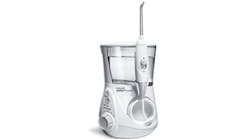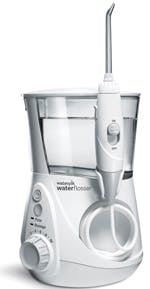Carol A. Jahn, RDH, MS, presents research about water flossing and addresses some common concerns clinicians have about recommending a water flosser.
By now, you’ve seen the ads, you've read the studies, and you've heard it discussed in continuing education courses: Water flossing is an easier and more effective way to floss. There is even TV advertising, and patients may be asking you about water flossing—but you just aren’t sure. There are some questions you need answered. For example, can it prevent caries? You are also worried about bacteremia. And besides, is it messy?
It's common to have concerns about patients being at risk for caries if they do not use a product that cleans contact points. The truth is that there have not been studies done to determine if the Waterpik Water Flosser cleans the contact or if it can prevent caries. What’s also true is that there have been no studies conducted about dental floss as a measure for preventing caries in adults. (1) Since caries is a multifactorial disease, adequate exposure to fluoride, diet modification, and good oral hygiene remain the best preventive measures. (2) What we do know from published research is that water flossing can remove up to 99.9% of plaque from treated areas,and it's significantly more effective than traditional dental floss for both plaque removal and gingivitis reduction. (3–5) To determine what product is right for an individual patient, a caries risk assessment, combined with sound clinical judgment, helps provide the best answer.
You may also be wondering if your patient who requires premedication can use a water flosser. While use of an oral irrigator was once considered taboo, the research today tells us that the rate of bacteremia from water flossing (7%–50%) is similar to the rate of bacteremia from traditional brushing and flossing (20%–68%) or even from chewing food (7%–51%). (6) The most recent American Heart Association guidelines note that maintaining good oral hygiene (along with eliminating oral disease) is the best way to decrease the frequency of bacteremia from routine daily activities. (6)
And then there is the objection that using a water flosser might be messy. You might worry about getting water all over the sink. The reality is that if you try to look at yourself in the mirror while water flossing, you might get wet. But there is a fix for that—good product instruction. What’s the best way to teach people how to water floss? Do it yourself. The only way you can help a patient troubleshoot the process of using a water flosser is if you know how to use it. And for those who can’t seem to get the hang of it, there are handheld, waterproof water flossers that can be used in the shower.
The science supporting the efficacy and safety of the water flosser is strong. Many have heard that a water flosser cannot remove plaque, likely because simple swishing with water is ineffective against plaque. But the research tells a different story. When compared to traditional string floss, water flossing has been shown to be significantly better for removing plaque and reducing bleeding and gingivitis. (4,5,7) A study at the University of Southern California Center for Biofilms found that a three-second water flossing application removed 99.9% of plaque biofilm. (3) The researchers observed via scanning electron microscopy that the combination of pulsation and pressure produced by the water flosser created shear hydraulic forces that effectively removed the plaque biofilm. (3)
When it comes to safety, the water flosser is supported by more than 60 clinical trials and five decades of use by the public. (8) A 2015 review of the safety profile on the water flosser found significant evidence to dispel the myth that water flossing may harm tissues. (8) Today, most practitioners have had positive experiences with patients using a water flosser, further putting the issue to rest. The water flosser has been found to be safe and effective for patients who have diabetes, patients in periodontal maintenance, patients with implants, and patients with orthodontic appliances. (9–12)
Skepticism is not necessarily a bad thing. A healthy dose of skepticism, coupled with scientific knowledge, is essential for using our critical thinking skills and making evidence-based, patient-centered recommendations. The evidence supporting water flossing is strong and conclusive.
Editor's Note: This article first appeared in Pearls for Your Practice: The Product Navigator. Click here to subscribe. Click here to submit a products article for consideration.
References
1. Sambunjak D, et al. Flossing for the management of periodontal diseases and dental caries in adults. Cochrane Database Syst Rev. 2011;(12):CD008829.
2. Jackson R, Zero D. Current evidence for caries preventive strategies. In: Frantsve-Hawley J, ed. Evidence-Based Dentistry for the Dental Hygienist. 1st ed. Hanover Park, IL: Quintessence Publishing Co. Inc.;2014.
3. Gorur A, Lyle DM, Schaudinn C, Costerton JW. Biofilm removal with a dental water jet. Compend Contin Educ Dent. 2009;30(Spec No 1):1–6.
4. Goyal CR, Lyle DM, Qaqish JG, Schuller R. Evaluation of the plaque removal efficacy of a water flosser compared to string floss in adults after a single use. J Clin Dent. 2013;24(2):37–42.
5. Barnes CM, Russell CM, Reinhardt RA, Payne JB, Lyle DM. Comparison of irrigation to floss as an adjunct to tooth brushing: Effect on bleeding, gingivitis, and supragingival plaque. J Clin Dent. 2005;16(3):71–77.
6. Wilson W, Taubert KA, Gewitz M, et al. Prevention of infective endocarditis: Guidelines from the American Heart Association. Circulation 2007;116:1736–1754.
7. Rosema NA, Hennequin-Hoenderdos NL, Berchier CE, et al. The effect of different interdental cleaning devices on gingival bleeding. J Int Acad Periodontol. 2011;13(1):2–10.
8. Jolkovsky DL, Lyle DM. Safety of a water flosser: A literature review. Compend Contin Educ Dent. 2015;36(2):146–149.
9. Al-Mubarak S, Ciancio S, Aljada A, et al. Comparative evaluation of adjunctive oral irrigation in diabetics. J Clin Periodontol. 2009;29(4):295–300.
10. Genovesi AM, Lorenzi C, Lyle DM, et al. Periodontal maintenance following scaling and root planing: A randomized single-center study comparing minocycline treatment and daily oral irrigation with water. Minerva Stomatol. 2013;62(Suppl. 1–12):109.
11. Magnuson B, Harsono M, Stark PC, et al. Comparison of the effect of two interdental cleaning devices around implants on the reduction of bleeding: a 30-day randomized clinical trial. Compend Contin EducDent. 2013;34(Spec No 8):2–7.
12. Sharma NC, Lyle DM, Qaqish JG, Galustians J, Schuller R. Effect of a dental water jet with orthodontic tip on plaque and bleeding in adolescent patients with fixed orthodontic appliances. Am J Orthod Dentofacial Orthop. 2008;133(4):565–571.
Carol A. Jahn, RDH, MS, is the director of professional relations and education for Water Pik Inc. She can be contacted at [email protected].








